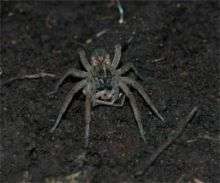In spiders, size matters: Small males are more often meals

Female spiders are voracious predators and consume a wide range of prey, which sometimes includes their mates. A number of hypotheses have been proposed for why females eat males before or after mating. Researchers Shawn Wilder and Ann Rypstra from Miami University in Ohio found, in a study published in the September issue of the American Naturalist, that the answer may be simpler than previously thought.
Males are more likely to be eaten if they are much smaller than females, which likely affects how easy they are to catch. In one species of spider, Hogna helluo, large males were never consumed while small males were consumed 80% of the time. This result was also confirmed when Wilder and Rypstra examined published data from a wide range of spider species. Males are more likely to be eaten in species where males are small relative to females.
Much research on sexual cannibalism has focused on a few extreme cases involving sexual selection and sperm competition. However, by looking at data on a wide range of spiders, Wilder and Rypstra discovered that the size of the male relative to the female (often referred to as sexual size dimorphism) determines how often sexual cannibalism occurs in a species.
"We were surprised to find that such a simple characteristic such as how small males are relative to females has such a large effect on the frequency of sexual cannibalism," states Shawn Wilder. In many cases, sexual cannibalism may not be a complex balancing act of costs and benefits for males and females but rather a case of a hungry female eating a male when he is small enough to catch.
In an interesting twist, evolution does not appear to be driving this relationship. For example, females would not become larger to consume more males because each male would then be a smaller meal to the larger female and males would not become smaller to be eaten more often because they would not get to mate as often. Rather, sexual cannibalism may be a byproduct of the evolution of large females and small males in a predatory species.
Shawn M. Wilder and Ann L. Rypstra, "Sexual size dimorphism predicts the frequency of sexual cannibalism within and among species of spiders" American Naturalist (2008) 172: 431
Source: University of Chicago















